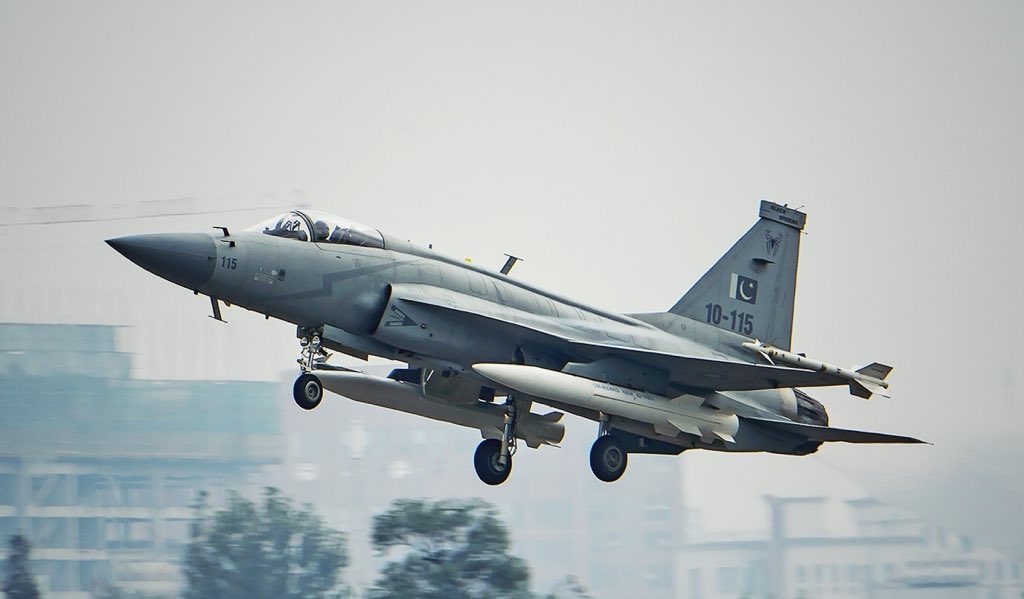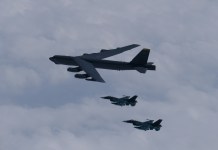A grab from a Pakistan Air Force (PAF) illustrative video of the Indus Shield air exercises circulating on social media offers a peek into how it plans to counter India’s Russian-origin S-400 surface-to-air (SAM) systems.
PAF’s Chinese-origin JF-17 Thunder and CM-400 anti-ship missiles figure prominently in the computer-generated promotional material.
The grab shows JF-17s working in tandem with the newly acquired J-10s and PAF’s Airborne Early Warning and Control (AEW) aircraft in a Suppression/Destruction of Enemy Air Defense (SEAD/DEAD) operation against the S-400.
The S-400’s massive 300 to 400-kilometer range has the potential to keep the PAF grounded or operating mainly in its airspace in a classic enhanced air-denial zone.
Such a scenario tremendously benefits the Indian Air Force (IAF) and India’s ground forces, significantly relieving them of the pressure from Pakistani air operations.
Pakistan has long been attaining technological advancement to match India’s conventional superiority. Fielding advanced Chinese weapons like the J-10C and the CM-400 can be a step in this direction.
The PAF’s Indus Shield exercise is a 14-nation drill including China, Saudi Arabia, Azerbaijan, Bahrain, Egypt, Germany, Hungary, Indonesia, Iran, Italy, Kuwait, Morocco, Oman, Turkiye, UAE and Uzbekistan.
“The exercise stands out as one of the mega aerial warfare exercises of the region and is marked as a significant milestone in the realization of PAF’s commitment to enhance its aerial capabilities alongside bolstering international cooperation,” the PAF said in a post on X (formerly Twitter).
S-400 Changed PAF’s Calculations
In a separate promotional video, Saudi Arabian F-15s, Turkiye’s F-16s, PAF’s F-16 Block 52 variants, a JF-17 Block 3, a Pakistani J-10C, and other medium-lift transport aircraft could be seen.
That video also showed Pakistan’s Akinci twin-engine armed drones in action. While it was not clear if the video of the drones was from another separate sortie or the same exercise, they will undoubtedly be employed in a conflict with India.

But the promotional video showed pre-existing footage of an S-400 in action, calling it a ‘Multi-Domain Threat Environment.’
PAF views the Indian Air Defense system as a threat and to have significantly complicated its strategic calculus, where neutralizing it becomes a primary operational goal, if not the only one.
To freely engage the IAF without the threat of the S-400, the PAF must devote resources, technology, and tactics to destroy the Air Defense system.
What The Video Grab Suggests
X (formerly Twitter) handle Air Operations Syndicate shared a frozen grab of a computer-generated illustrative video claimed to be from Indus Shield’s publicity materials.
“Pakistan Air Force Official, Indus Shield PR, reveals an interesting tactical scenario of Exercise showing JF-17 targeting an enemy High Tech SAM using the supersonic CM-400 missiles. PAF seems to be employing anti-S-400 tactics in the ongoing exercise,” it said.
The picture shows digital representations of Pakistani and Indian air and ground forces arrayed against each other, with the Indian side colored red. ‘Domes’ symbolize the protective cover of air defense systems, and the size of the ‘dome’ on the Indian side is more extensive, proving that the PAF recognizes the massive air-denial capability of the S-400.
A quartet of JF-17s are shown firing what are claimed to be two CM-400 anti-radiation missiles. J-10Cs and F-16s, the frontline multi-role air-superiority fighters, are meanwhile flying Combat Air Patrols (CAP) and providing integral defense to the JF-17s.
Like the Tejas Mk1A, the JF-17s — even the latter advanced Block III — are less likely to be used as a frontline multi-role fighter. It would instead be employed as a rearguard and point defense/air defense jet, guarding critical military facilities and bases.
It can also undertake a ‘missile truck’ role, firing beyond visual range (BVR) missiles at targets designated by the more advanced F-16s and J-10s.
The JF-17 is not an older-generation fighter like Ukraine’s Russian-origin Su-24 Fencer or MiG-29 but is still a relatively less advanced jet in the PAF hierarchy.
It has thus been envisaged to undertake SEAD/DEAD roles like the MiG-29 that now fires the AGM-88 High-Speed Anti-Radiation Missile (HARM) or long-range standoff ground attack like the Su-24, firing the Storm Shadow/SCALP cruise missiles.
Pakistani Tactics & Intentions
While the full video of which the grab is a part could not be found, two subsequent follow-on actions can be assumed to be carried out by the Pakistan military once the S-400 is destroyed.
- Pakistan’s aircraft will undertake bolder battlefield interdictions and air-to-ground strikes on Indian land targets once the protective cover offered by the S-400 is lifted. Its ground forces, too, will have more freedom from Indian aircraft since IAF jets would have to contend with the Pakistani fighters in the air that now operate without the fear of S-400.
- If the war has escalated and both sides see a chance for retribution under a high nuclear threshold, the freedom from S-400s will also motivate more ambitious PAF and Pakistan Army plans to venture deep into Indian territory. A host of political and diplomatic variables would decide where these incursions would be and whether the goal is to permanently control the land or use it as leverage for future negotiations or ceasefire talks.

Nevertheless, the CM-400 does pose a significant threat to the S-400. But the PAF, too, would need a high level of training, unparalleled sophisticated tactics, and disciplined coordination between the decoys launched to bait the S-400 into ‘lighting up’ and the launch aircraft receiving the command to fire the CM-400 — possibly upon receiving targeting location via data links.
Moreover, once the JF17-CM400 pair becomes operational, which IAF headquarters and intelligence will be closely monitoring, it too will be considerably constrained in using the S-400s all the time. This will prevent their radar gathering frequencies and locations from being picked up by Pakistani electronic intelligence (ELINT) systems.
Forcing the IAF to carefully and cautiously use the S-400 would be a significant tactical achievement for the PAF.
Why The CM-400?
This leaves the question of why the PAF would use the Chinese supersonic CM-400, essentially billed as an “aircraft carrier killer,” against the S-400.
It can be used to expend the S-400’s battery of missiles to detect the rocket entering Indian air space and use the time to attain a quick tactical victory over Indian fighters or ground targets.
The S-400 uses a combination of the 40-kilometer-range 9M96E, 120-kilometer-range 9M96E2, 250-kilometer-range 48N6, and 400-kilometer-range 40N6E missiles. It, therefore, also depends upon which of these missiles India has acquired and whether it forward deploys the S-400 or keeps it in the rear to protect vital installations.
- The author can be reached at satamp@gmail.com
- Follow Eur Asian Times on Google News




